
The fifth episode of Justin Simien’s Netflix series, Dear White People, is its most unsettling: a look at the world of Winchester University through the wary eyes of Reggie (Marque Richardson), a student activist. The story climaxes with a racially charged confrontation at a party between Reggie and an insensitive white student that prompts a visit from a campus security officer, who pulls a gun on Reggie and demands to see his ID.
The episode was written last year by Chuck Heyward and Jack Moore and directed by Barry Jenkins, whose film Moonlight, a future multiple Oscar winner, had not yet been commercially released. I spoke to Jenkins about his direction of the episode. An edited transcript of our conversation follows.
How did you end up directing this episode?
Justin had seen an early cut of Moonlight, and he said, “Hey, I would love for you to direct an episode.” And I said, “Well, I would love to, but I need you to know that I’m going to be busy every day promoting Moonlight,” and he was like, “Nahnahnahnahnah, don’t worry. It’ll just be people walking and talking at a college!” And I said, “Okay, fine.”
And then I got the script, and … [Laughs] Let’s say they went in a much different direction than walking and talking!
Did you have anything to do with setting the look of the show, or was that all in place when you set foot on the set?
No, that’s all Justin. I saw the movie this show was based on, and I knew Justin had a great eye. They sent all the other directors who worked on the show this sort of visual, uh, principles book — whatever you want to call it — that gave us an idea of how to approach directing episodes of Dear White People. Justin and [series cinematographer] Jeffrey Waldron did a great job of building a visual aesthetic that we could all walk into. But within that aesthetic, we had freedom. They made it clear that they had hired specific directors because they liked their visual voices and wanted us to put our own spin on things.
Dear White People is a very cinematic show. A lot of attention has been paid to how the camera moves, where people are in the frame, how the music is used. I wonder how much of this is indicated on the page, though? When you get a script, are there shots indicated on the page, or is it all general description and dialogue?
No, we had total visual freedom. I mean, Jeff shoots every episode, so there are some guiding principles, and Justin was always around so that we could cross-reference our choices and ask, “Does this work for the world of Dear White People?” But the really cool thing about the show is that it shifts perspective, and that means it’s kind of okay for a Reggie episode to look different from, say, a Sam episode or a Coco episode. You feel that there’s a defensible reason for that, because of the show’s Rashomon-like narrative structure.
Justin told me, “You are here to be you.” Remember, when Justin brought me in, he had more information about me at that point than I did about the show, because by that point Justin had seen Moonlight already. He chose me to direct this episode based on Moonlight.
Let’s talk about the direction. This is a show that isn’t afraid to do close-ups where people seem to be looking right into the camera, or almost into the camera. That’s a kind of shot that Spike Lee uses a lot, and it was probably perfected by the late Jonathan Demme. Every episode ends with a variation of that kind of shot. But in this Reggie episode, it seems you’ve got more of those shots sprinkled throughout, even in scenes where you might not necessarily expect to see them.
That is a Dear White People thing, that shot, especially at the ends of episodes where they’re looking directly into the camera. You know, I like that shot! I did that kind of thing in Moonlight, so I was like, “Yeah, I know what this is.” Justin had created the perfect sandbox for me to play in.
But here, that shot was about centering Reggie. Reggie is an interesting guy. He’s very focused and he cares very passionately about a lot of things, and in previous episodes of the show, those things were not allowed to be centered, because he was not the main character. He was on the periphery.
So when you shoot a scene that way, it’s about literally centering Reggie: his interests, his focus.
Especially in one scene that occurs very early in the episode. And in the scene, you have Reggie on one side of the conversation, by himself, right in the center of his own frame. Facing him, you have this wall of other characters, and they’re pictured either in a three-shot or a two-shot. A lot of the time Reggie is looking very directly at them.
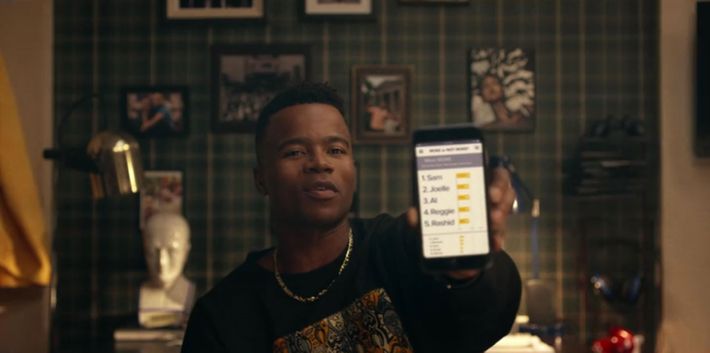
Except when he’s not the center of attention or feeling insecure. Then you go to other angles that show Reggie or the other characters as seen from the side. Not all the time — it’s not mathematical. But there seems to be some logic to it.
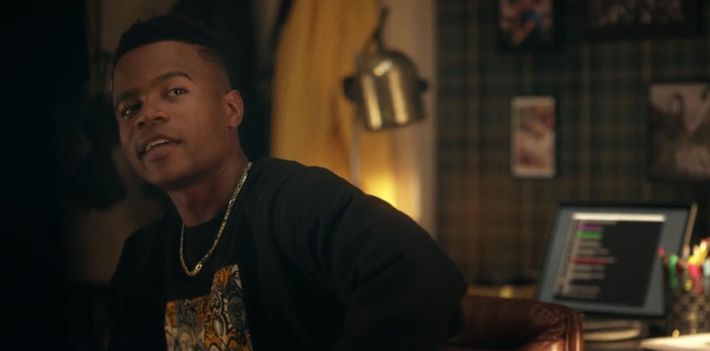
What we’re trying to do here is work the audience very directly into this character’s consciousness. We are trying to work the audience into an empathic feeling, so that we understand what it’s like to be Reggie.
Then in that final shot of the episode, I thought, well, by this point we know what it feels like to have Reggie watching us, so now I want Reggie to feel like we’re watching him. I want the camera to creep in on him subtly, from the perspective of the television viewer. Not necessarily the idea of a surveillance state watching Reggie — what I mean is that I wanted the audience to feel themselves gradually getting closer and closer to this character.
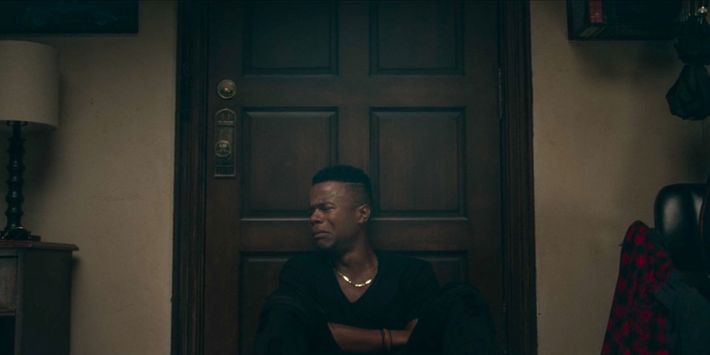
A lot of people have described that shot as a zoom shot on Marque. It’s not a zoom shot. It’s actually a dolly shot [where the camera is placed on wheeled dolly that moves on a track]. I had to say to Marque, “Look, I know we normally work with long lenses on this show, but I’m gonna put a wider lens on this camera and move it physically closer to the actor, would that be okay?” And he said, “Yes, that’s okay.”
Why was that important to you, using a dolly instead of a zoom?
Because we wanted Marque to look at the camera at a particular moment, and we did not want the audience to be able to avoid the pain that the character is feeling. Also, as a director, I didn’t want to have to tell Marque, when we were shooting the scene, “Now look at the camera,” which you have to do when you’re far away from the actor zooming in. Then I had to ask myself, Well, how can I avoid having to tell him when to look at the camera, while still making sure that Marque looks at the camera at the moment that will allow this moment to reach its fullest emotional apex?
I realized that we could do that if we used a dolly, because when you do that shot with a dolly the actor can actually feel the camera moving closer to him. I wanted Marque to feel the eye of the audience through the camera as it got closer to him.
And he did feel it.
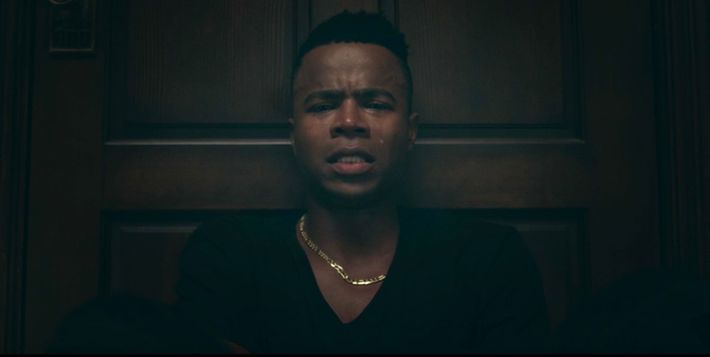
By the way, that other camera in the scene, the one that’s by the door and that gives us that one brief shot of Marque, the one in three-quarters view — that one doesn’t have a long lens on it, either. That camera was right next to Marque’s face! He is so comfortable on-camera.

Hearing you describe directing the episode, I feel like I’m hearing an actor describe how they’re going to get into character to play a part: How do I play Reggie? Except you’re not playing Reggie in front of the camera — you’re playing Reggie behind the camera. You have to get into the mind and under the skin of Reggie and represent his feelings externally, through the visuals.
Yes. But I also want to be clear, after having said all that, that Marque ultimately deserves the lion’s share of the credit for the emotional impact of the closing shot, and also Justin for casting him, and the show’s writers, who constructed the character’s scenario. After all of that, I’m just a facilitator.
I also want to say that even though we preplanned a lot, because we didn’t have much time to shoot and everything happens so fast on a set, we did try to leave room for inspirations and accidents — for things to happen spontaneously.
Can you give me an example?
During the party, there’s the trivia sequence. We shot that entire thing in 45 minutes. A piano just happened to be there. I saw that and I was like, “Oh! This piano has got to be a part of this scene.”
There was one cue in particular that they replaced, in the opening section, where we’re kind of going around with Reggie … part of The Nutcracker, I think it’s the piece they play in all the Christmas commercials?
“The Dance of the Sugar Plum Fairy”?
Yes! “The Dance of the Sugar Plum Fairy.” There’s that beautiful scene where Marque is walking past the coach, and he says, “Good one, Marcus” — that originally had “Dance of the Sugar Plum Fairy” under it, and I thought, “This isn’t Reggie.”
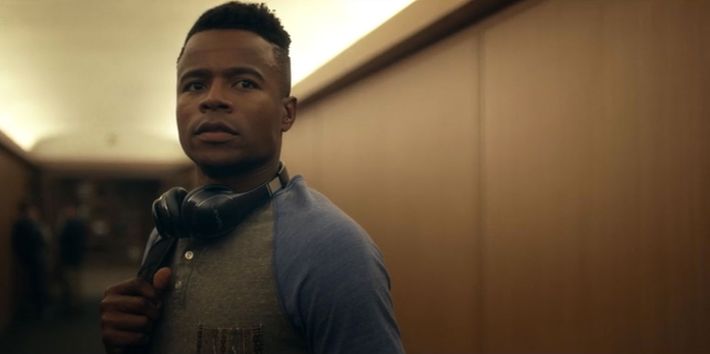
I thought it was a beautiful stroke that they ended up scoring so much of the episode with jazz. The dominant musical forms that African-Americans created in this country are jazz, blues, and rock and roll. But particularly blues and jazz. I heard that jazz in the episode and I thought, “Yeah, that’s right — Reggie is a jazz man.” He’s not a Nutcracker man, you know?
We should talk about the confrontation at the party where the campus security officer pulls a gun on Reggie and demands to see his ID. How did you film it?
That was the last day of the shoot. A lot of the scene was about blocking. They found this beautiful location, that house. I always thought about that last ten minutes of episode five as one organic scene. The goal was to create a party environment that felt very real, organic, and visceral, and then sort of hide the fuse, so that you don’t see it coming — the fact that this gathering of people is going to erupt in this explosive confrontation.
We shot the whole thing pretty much in sequence, moving from one room to the next, and by the time we came to shoot the actual scene — look, myself, Justin, and Marque are young black men. The distance between our experience and the characters’ experience is not very far.
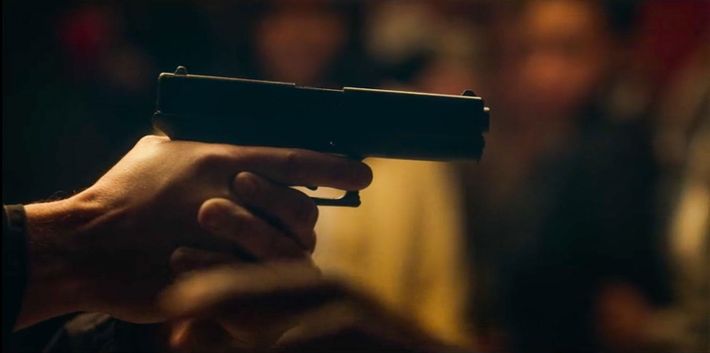

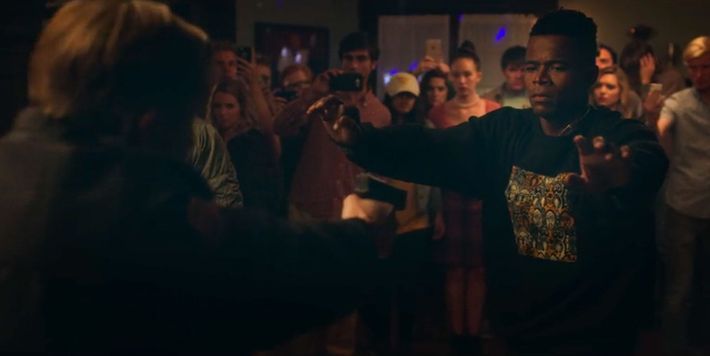
What did it feel like, shooting a scene that connects so bluntly with incidents that are in the news constantly?
It’s interesting … Like I was saying earlier, Justin had more information than I did going into this, because he had seen Moonlight and I had not yet read the script of episode five when he asked me to direct it, and what happens in that episode is more like what you would expect to happen in the world of Moonlight than in the world of Dear White People, in the hallowed halls of Winchester. And yet, of course, these things do happen at places like that.
So directing that scene was about very organically living in the truth that there is always the possibility of this sort of thing happening — that the threat is always present in the American society we live in today.
Why did you decide to stage the bulk of that confrontation with no music? You bring it in again at the end, but it’s subtle. The choice stands out because this is otherwise a music-driven show.
That was something we all decided on when we were on set: myself, Justin, and [executive producers] Yvette [Lee Bowser] and Stephanie [Allain]. I thought the conversation that was happening in that scene was so real that there was no need to bring in any artifice. The energy between the characters would carry the day.
That was the most emotional I’ve ever felt on a set. Everybody was crying. When that gun was pointed at Reggie, it felt like it was pointed at everyone. The gravity, the reality of what we were doing was clear. And everybody approached the material with clear eyes.


